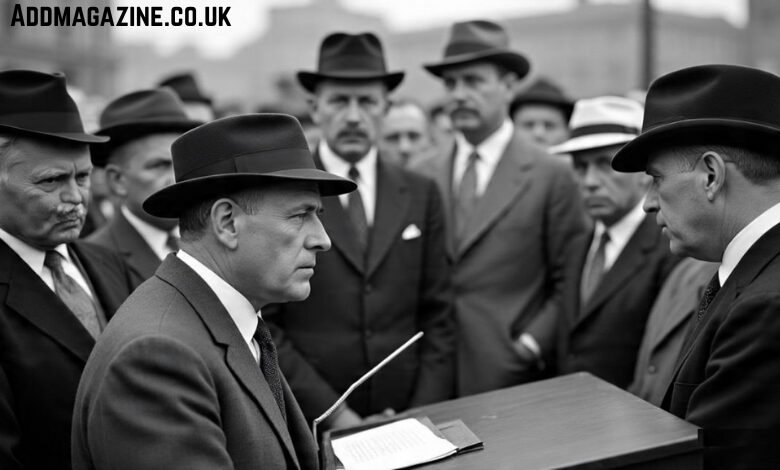The word fascisterne is the Danish plural definite form of fascist, meaning “the fascists.” It is most often used to describe individuals, organizations, and political parties that followed fascist ideology during the interwar period and World War II. In Denmark, the word became strongly associated with the country’s National Socialist Workers’ Party and other groups that sought to imitate the fascist regimes of Benito Mussolini in Italy and Adolf Hitler in Germany.
To understand what fascisterne represented, it is necessary to look at the broader history of fascism in Europe, the role it played in Denmark and Scandinavia, and the consequences for those who supported it during and after the Second World War.
The Origins of Fascism
Fascism as a political ideology developed in Italy following World War I. Benito Mussolini founded the National Fascist Party in 1921, calling for a strong, centralized state that rejected both liberal democracy and socialism. Fascism promoted nationalism, order, and loyalty to a single leader.
The word itself derived from fasces, a Roman symbol of authority consisting of rods bound around an axe. Mussolini adopted the symbol to convey strength through unity.
Key elements of fascism included:
- Authoritarian leadership: A single leader held ultimate power.
- National unity: The state emphasized homogeneity and loyalty to the nation.
- Anti-democracy: Fascism opposed multi-party democracy and liberal values.
- Anti-communism: It rejected socialism and communism as threats to order.
- Militarism: Fascist movements promoted armed strength and discipline.
In Germany, fascist principles influenced Adolf Hitler’s National Socialist German Workers’ Party. While Nazism incorporated its own racial ideology and anti-Semitism, its authoritarian and nationalist foundations were closely related to Mussolini’s model.
The Spread of Fascist Movements
The success of Mussolini and Hitler inspired similar movements across Europe. Small groups began appearing in Britain, France, the Low Countries, and Scandinavia. They copied the uniforms, salutes, and propaganda methods of the Italian and German models.
In Denmark, Norway, and Sweden, fascist groups presented themselves as alternatives to parliamentary democracy. They argued that existing governments were weak and divided, and that only strong centralized leadership could protect their nations from communism and external threats.
Fascisterne in Denmark
Early Formation
In Denmark, the most significant fascist organization was the Danmarks Nationalsocialistiske Arbejderparti (DNSAP), founded in 1930 by Cay Lembcke. The party soon came under the leadership of Frits Clausen, a physician from North Jutland, who became the most recognized figure among Danish fascists.
The DNSAP modeled itself directly after the German Nazi Party. Members wore uniforms, used the Hitler salute, and ran rallies that closely resembled those in Germany.
Ideology
The Danish fascists promoted:
- A strong, nationalist state.
- Hostility toward communism and socialism.
- Corporatist economic policies.
- Loyalty to Denmark but alignment with Germany.
- Anti-Semitism, though less central than in German Nazism.
Clausen believed that Denmark should follow Germany’s lead and that cooperation with Hitler’s Reich would secure the country’s future.
Political Efforts
The DNSAP participated in Danish elections, but their results remained limited. In the 1939 general election, they achieved only around 1.8% of the national vote. Despite their organized rallies and propaganda, they never became a mainstream political force.
Still, fascisterne maintained visibility. They published newspapers, attempted to recruit young members through paramilitary groups, and sought influence in political debate.
Fascisterne During the German Occupation
April 1940 Invasion
On 9 April 1940, Nazi Germany invaded Denmark. The Danish government chose to surrender quickly, and the country was occupied with relatively little destruction. This moment gave Danish fascists hope that they could become partners in a new order.
Collaborationist Ambitions
Frits Clausen saw himself as a potential leader under German rule, much like Vidkun Quisling in Norway. He expected that Germany would appoint the DNSAP to govern Denmark. However, the Germans chose a different path. They preferred to keep Denmark’s monarchy and government in place under supervision, as this allowed for smoother control.
As a result, Clausen and the DNSAP were sidelined. They continued to support Germany but did not achieve the power they had anticipated.
Participation in the War
Some Danish fascists joined German military units, especially on the Eastern Front. The best-known unit was Frikorps Danmark (Free Corps Denmark), established in 1941. It consisted of Danish volunteers who fought as part of the Waffen-SS against the Soviet Union. Many of its members were drawn from fascist circles, though not all were formally affiliated with the DNSAP.
Public Perception
For most Danes, fascisterne were seen as traitors. Their collaboration with Germany made them deeply unpopular. Resistance groups targeted fascist supporters, while the general population viewed them with suspicion and hostility.
The Decline of Fascisterne After 1945
German Defeat
When Germany surrendered in May 1945, the Danish fascist movement collapsed. Their association with the occupiers made them politically and socially discredited.
Trials and Punishments
In the post-war legal process, many fascists faced prosecution. Members of Frikorps Danmark and those who collaborated with German authorities were arrested. Some received prison sentences, while others lost civil rights.
Frits Clausen himself was arrested in May 1945. He died in prison two years later before his trial concluded. The DNSAP was permanently dissolved, along with all other fascist organizations.
Social Consequences
Former fascists found it difficult to reintegrate into society. They were often stigmatized and remembered as collaborators. The term fascisterne carried negative connotations long after the war, symbolizing betrayal and disloyalty to Denmark.
Fascisterne in the Wider Scandinavian Context
Norway
In Norway, fascism was represented by Nasjonal Samling, led by Vidkun Quisling. Unlike in Denmark, Quisling was installed as head of government under German occupation. His name became synonymous with treachery, and after the war he was executed for collaboration. Norwegian fascists, like their Danish counterparts, also supplied volunteers to the Waffen-SS.
Sweden
Sweden remained neutral during the war, but several small fascist groups operated within the country. They never gained wide support, though some admired Germany’s military power. Sweden’s government monitored them closely, and they played no significant political role.
Finland
In Finland, far-right and anti-communist groups emerged, particularly during the Winter War and Continuation War against the Soviet Union. While some adopted fascist elements, Finnish politics were shaped more by the fight against communism than by full-scale fascism.
Characteristics of Fascisterne
From Denmark and the broader Scandinavian experience, several defining traits of fascisterne can be identified:
- Imitation of Germany and Italy – They borrowed symbols, language, and organizational models from the larger fascist powers.
- Limited electoral support – They remained fringe groups with only small percentages of the vote.
- Reliance on German power – Their main influence came during the occupation, not through independent political strength.
- Association with collaboration – They were widely remembered for siding with the occupiers rather than defending national independence.
- Rapid decline – After 1945, they disappeared quickly, leaving only a historical legacy.
Legacy of Fascisterne
Although fascist groups vanished after the war, their presence left lasting marks on Danish society.
- Historical study: Scholars have examined how fascism spread and why it failed to gain broad support in Denmark.
- Public memory: For many Danes, fascisterne remain linked to occupation and betrayal.
- Cultural references: In discussions of the war years, the term is used to describe those who actively supported Germany.
Unlike in Italy or Germany, fascism in Denmark never controlled the state, but its existence illustrates how international movements can influence smaller countries.
Conclusion
Fascisterne — the fascists — in Denmark and Scandinavia were part of a wider European wave of authoritarian nationalism in the 1930s and 1940s. In Denmark, they centered on the DNSAP under Frits Clausen, drawing inspiration from Mussolini and Hitler. Despite attempts to gain political ground, they remained marginal in elections. Their main role came during the German occupation, when some collaborated and others fought for Germany on the Eastern Front.
After 1945, they were discredited, prosecuted, and remembered as collaborators. While their political power disappeared, the memory of fascisterne continues to represent a warning about the appeal of authoritarian movements and the consequences of aligning with foreign occupiers.




